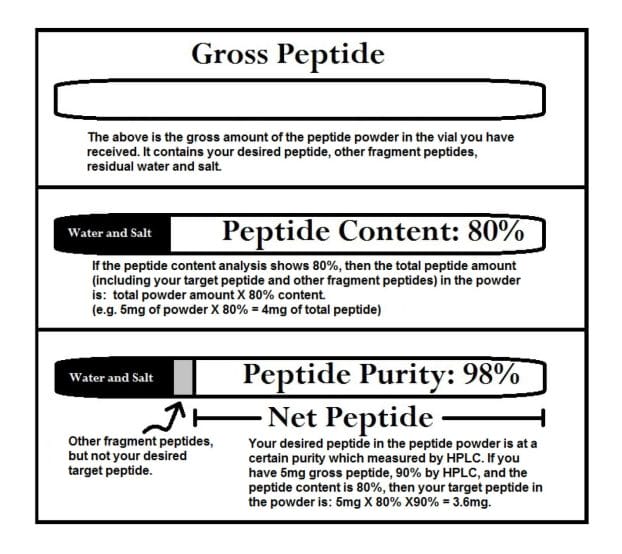Scenario: You purchase a peptide with an advertised content of 5mg at ≥98% purity but it weighs 6.25mg. What’s going on, why does your peptide weigh so much?
This is a great question and goes to the heart of why there is so much confusion and false advertising in the peptide industry. To begin, please review the following peptide content diagram:
There are 4 major components to a Gross Peptide. The active peptide chain, off target peptide fragments, water, and the counterion that forms the salt. Let’s dig into each one:
- Active Peptide Chain – this is the active ingredient you are interested in. Presumably if you purchased 5mg you expected to have a net active peptide mass of 5mg. Unscrupulous vendors will sell you a gross peptide weighing 5mg, including water, salt and impurities. This can mean you get 80% to 30% of the net active peptide mass you expected.
- Off Target Peptide Fragments – these are amino acids and peptide chains that failed to form the correct active peptide chain. It is impossible to fully eliminate off target peptide chains but they can be reduced to a high degree. We use the highest industry research standard of ≤2%.
- Water (Moisture) – amino acids absorb moisture from the air so it is difficult to fully eliminate moisture from peptides. We limit moisture content to ≤5% w/w which is the highest industry standard.
- Counterion (Salt) – the counterion of a peptide is an important excipient molecule selected to improve the active peptide’s stability and solubility, together with the active peptide it forms an ionic bond and salt molecule. The most popular counterion is TFA because of its economy and excellent stability and solubility properties. However it is mildly toxic so we generally replace it in favor of Acetate or Hydrochloride. The amount of counterion varies with the ionic properties of the active peptide chain.
What is Peptide Purity?
If a large portion of peptide is water and counterion, how can anyone claim peptides to be ≥98% pure? In the peptide industry the purity level refers to the measurement of amino acids that made it into the proper chain to form the peptide. The leftover 2% are amino acids that for whatever reason didn’t make it into the proper sequence are the off target peptide fragments. So you can think of peptide purity as equal to
